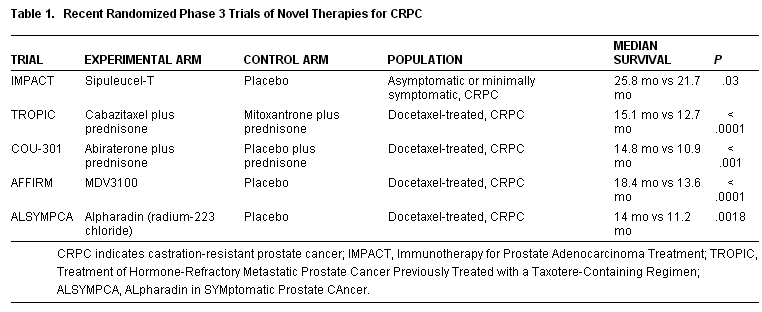Docetaxel plus Prednisone or Mitoxantrone plus Prednisone for Advanced Prostate
Cancer
I. F. Tannock and Others NEJM 2004;351:1502
About 10 to 20 percent of men with prostate cancer present with metastatic disease, and in
many others, metastases develop despite treatment with surgery or radiotherapy. Treatment
of metastatic prostate cancer is palliative. In about 80 percent
of men, primary androgen ablation leads to symptomatic improvement and a reduction in
serum levels of prostate-specific antigen (PSA), but in all patients the disease
eventually becomes refractory to hormone treatment. The options then include
symptomatic care with narcotic analgesics, radiotherapy to dominant sites of bone pain,
treatment with bone-seeking isotopes such as strontium-89, and cytotoxic chemotherapy.
Bisphosphonates may reduce skeletal complications, and low-dose prednisone or
hydrocortisone may be palliative in some patients.
Chemotherapy can reduce serum PSA levels in patients with hormone-refractory prostate
cancer and relieves pain in some patients, but tolerability is of concern, particularly
since most patients are elderly and many have other medical problems. A randomized trial
showed that mitoxantrone plus low-dose prednisone relieved pain and improved the quality
of life more frequently than did prednisone alone. Consistent benefits of mitoxantrone
plus a corticosteroid were observed in other randomized trials, but none found that this
approach improved survival. These trials established mitoxantrone
plus a corticosteroid as the treatment of reference for hormone-refractory prostate
cancer.
Phase 2 studies of the taxane docetaxel have reported PSA responses (defined as a
reduction in serum PSA levels of at least 50 percent) in up to 50 percent of patients.
Studies of docetaxel plus either estramustine or calcitriol have shown PSA responses in up to 80 percent of patients.
From March 2000 through June 2002, 1006 men with metastatic hormone-refractory prostate
cancer received 5 mg of prednisone twice daily and were randomly assigned to receive 12
mg of mitoxantrone per square meter of body-surface area every three weeks, 75 mg of
docetaxel per square meter every three weeks, or 30 mg of docetaxel per square meter
weekly for five of every six weeks.
Results As compared with the men in the mitoxantrone group, men in the group given docetaxel every three weeks had a hazard ratio for death of 0.76
and those given weekly docetaxel had a hazard ratio for death of 0.91. The median survival was 16.5 months in the mitoxantrone group, 18.9 months
in the group given docetaxel every 3 weeks, and 17.4 months in the group given weekly
docetaxel. Among these three groups, 32 percent, 45 percent, and 48 percent of
men, respectively, had at least a 50 percent decrease in the serum PSA level (P<0.001
for both comparisons with mitoxantrone); 22 percent, 35 percent (P=0.01), and 31 percent
(P=0.08) had predefined reductions in pain; and 13 percent, 22 percent (P=0.009), and 23
percent (P=0.005) had improvements in the quality of life. Adverse events were also more
common in the groups that received docetaxel.Docetaxel and
Estramustine Compared with Mitoxantrone and Prednisone for Advanced Refractory Prostate
Cancer
D. P. Petrylak and Others NEJM 2004;351:1513
Men with newly diagnosed metastatic prostate cancer have a rapid response to surgical
or medical castration, with improvement in bone pain, regression of soft-tissue
metastases, and a decline in serum prostate-specific antigen (PSA) levels. Nevertheless,
in virtually all patients the tumor ultimately becomes androgen-independent a median of 18
to 24 months after castration. Patients with metastatic androgen-independent prostate
cancer have a progressive and morbid disease with a median survival of 10 to 12 months;
currently, no treatment offers a survival advantage. Chemotherapy for androgen-independent
prostate cancer is ineffective: mitoxantrone plus prednisone or hydrocortisone, the
current standard of care, palliates bone pain in approximately 30 percent of patients but
does not improve survival.
We randomly assigned 770 men to one of two treatments, each given in 21-day cycles: 280
mg of estramustine three times daily on days 1 through 5, 60 mg of docetaxel per square
meter of body-surface area on day 2, and 60 mg of dexamethasone in three divided doses
before docetaxel, or 12 mg of mitoxantrone per square meter on day 1 plus 5 mg of
prednisone twice daily.
Results Of 674 eligible patients, 338 were assigned to receive docetaxel and estramustine
and 336 to receive mitoxantrone and prednisone. In an intention-to-treat analysis, the median overall survival was longer in the group given docetaxel and
estramustine than in the group given mitoxantrone and prednisone (17.5 months vs. 15.6
months, P=0.02 by the log-rank test), and the corresponding hazard ratio for death was 0.80 (95 percent confidence
interval, 0.67 to 0.97). The median time to progression was 6.3 months in the group given
docetaxel and estramustine and 3.2 months in the group given mitoxantrone and prednisone
(P<0.001 by the log-rank test). PSA declines of at least 50 percent occurred in 50
percent and 27 percent of patients, respectively (P<0.001), and objective tumor
responses were observed in 17 percent and 11 percent of patients with bidimensionally
measurable disease, respectively (P=0.30). Grade 3 or 4 neutropenic fevers (P=0.01),
nausea and vomiting (P<0.001), and cardiovascular events (P=0.001) were more common
among patients receiving docetaxel and estramustine than among those receiving
mitoxantrone and prednisone. Pain relief was similar in both groups.
|




